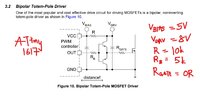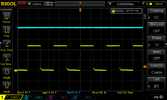Hi, I am a complete beginner in using MOSFET, so please bear with me.
As attached is my schematic. I am using ATtiny1617 as my IC which outputs a PWM signal around 200Hz.
I am trying to turn on and off the gate of my N-channel MOSFET STD85N3LH5 using the totem-pole configuration.
I have attached my signal as well.
CH1 yellow - Gate signal
CH2 blue - Vdrive
My issues:
1) I am expecting to get a 8V PWM on the gate signal but I am getting 5V instead. Is there something wrong with my understanding? Since I am supplying 8V to my VDRV.
2) The gate signal is not completely turned off, there is a slight delay as you can see from the waveform. Is it because of my PNP transistor selection?
Please kindly assist me.
Thank you.
As attached is my schematic. I am using ATtiny1617 as my IC which outputs a PWM signal around 200Hz.
I am trying to turn on and off the gate of my N-channel MOSFET STD85N3LH5 using the totem-pole configuration.
I have attached my signal as well.
CH1 yellow - Gate signal
CH2 blue - Vdrive
My issues:
1) I am expecting to get a 8V PWM on the gate signal but I am getting 5V instead. Is there something wrong with my understanding? Since I am supplying 8V to my VDRV.
2) The gate signal is not completely turned off, there is a slight delay as you can see from the waveform. Is it because of my PNP transistor selection?
Please kindly assist me.
Thank you.


